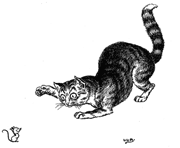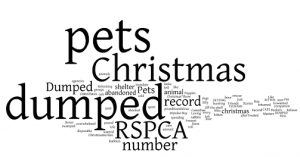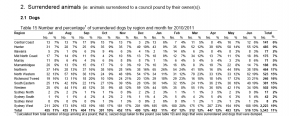The image here is one I created using the headlines from 3 pages of Google results searching for the information on whether people really do dump their pets at Christmas.
The “fact” that there is a huge influx of dumped and abandoned pets is so common and so often replicated by animal shelters, pounds and rescue groups that you’d think the evidence would be really easy to come by. In fact monthly intake figures for pounds and shelters are not that easy to find, which was a bit of surprise given the wide acceptance of the belief that there is a huge spike in pets abandoned or surrender to pounds and shelters at Christmas time.
One study done in 2005 tracks intakes of cats to Melbourne shelters. (1)
Marston, et al found that only 21% of cats impounded were owner surrenders – the rest were brought in as strays by animal management officers. Over 51% of cats admitted were kittens and on page 22 they graph admissions by month and conclude:
As can be seen from Figure 4 there is a clearly defined ‘kitten season’ apparent in the data which occurs at the warmest time of the year, starting in December and continuing through until April of the following year. The admission rates of cats in the other age groups vary relatively little throughout the year.
Now clearly in Australia Christmas occurs in the warmer months of the year, so it makes sense that there would be a surge in the numbers of young animals arriving in pounds. That’s all about biology – many animals mate in time to have babies in the late spring and early summer when food is plentiful and feeding babies is a bit easier. Cats tend come into season as the days start to get longer and will kitten through November, December and January, tapering off into autumn. Dogs are a bit different with female dogs coming into season about twice a year, but there seems to be some seasonal influence. It’s not unlikely that people faced with an unexpected litter from the family dog, or finding a mother cat and babies in the shed, would take them to a pound. Indeed, the Marston et al article found that the most common reason for the surrender of cats was “too many cats” and most of the cat surrendered in this category were kittens.
So while it is true that more cats end up in the pound around Christmas time, the reasons are to do with feline biology, there are many, more cats around at that time of the year. Since we know that around 90% of owned cats are desexed, this population of kittens is from the unowned and possibly feral cat population and people taking litters of kittens to the pound are probably not “dumping” them, but attempting to be responsible for unwanted kittens.
A 2005 study looking at outcomes for shelter dogs in Melbourne found that there was a peak of dog admissions in December, January and February (p32), although their date was incomplete and they were working from partial years for different shelters. (2)
However, the NSW Department of Local Government tracks admissions of seized (stray) and owner surrendered dogs and cats to council pounds and they break this data down by region and month. (3)
Table 1 is the numbers of seized (stray) dogs by month and region. As you can see, there is variability of numbers across months and regions, but no clear spike in seized dogs in the Dec/Jan/Feb period. The DLG notes, “the total number of dogs seized in each month varied by some 15%, with the highest number seized occurring in August at 3,047, and the lowest number in October at 2,618.”
Table 2 is the numbers of seized (stray) cats by month and region, which shows a clear spike in kitten season, but minor variation across the rest of the year. It’s safe to assume that the spike in cat numbers are kittens, which bears out the findings of Marston, et al, and accords with what we already know about cat admissions.
Table 3 is the number of owner surrendered dogs by month and region. If there was going to be a huge increase in surrenders at Christmas you’d expect to see it in this table. In the total admission figures there is a small increase in owner surrenders in the summer months, but that’s not consistent across regions and in the total figures, there were more dogs surrendered in March than in January. The average number of dogs surrendered to pounds across all regions of NSW per month was 424.
Table 4 is owner surrendered cats which shows, as we would expect, a huge increase in the numbers of cats surrendered to pounds in the summer months, although its not clear how many of them are kittens as opposed to adult cats. The Victorian research suggests that the spike is a consequence of litters of unwanted kittens, or mother cats with their kittens, rather than already owned cats being abandoned. And since the spike in kitten numbers is seasonal, it’s impossible to draw any conclusions about how many, if any, of those kittens are unwanted Christmas gifts.
So from the figures we can conclude that while there is a huge increase in cats entering pounds in the summer months, there is little evidence for a huge increase in dog surrenders. Since the DLG doesn’t track the animals by age, its difficult to know if there is an increase in the surrender of litters of puppies. However, it is probably safe to conclude that while there may be some variation in the numbers of dogs entering pounds at various times of the year, there isn’t much evidence for a huge influx of unwanted dogs over Christmas.
The South Australian RSPCA recently had this to say on their Facebook page, “Mythbusting: There is a widely-held view that animal shelters are flooded with unwanted “gift animals” early in the new year. We’ve not experienced this in our shelters, in fact our surrender rates in January and February are on average lower than the rest of the year.”
If you do a scan of the articles which appear world-wide about “Christmas dumping”, the same reasons appear over and over again. This article from a Melbourne newspaper in 2012 is really typical of the theme:
RSPCA says scores of pets dumped during holidays
HUNDREDS of dogs and cats are on death row at the Burwood RSPCA after being dumped since Christmas.
The animal shelter was overrun with 229 surrendered and stray dogs and 129 cats once the festive cheer had worn off.
She said owners were either treating their pets as unwanted gifts or couldn’t be bothered finding someone to mind them while away on holidays.
“Unwanted litters of puppies and kittens are also surrendered to shelters over the Christmas period, often the result of unplanned breeding or being unable to rehouse all the littermates,” Ms Currey said. (4)
Apart from kitten season, there are two reasons given here for the supposed influx of dumped animals. The first is unwanted gifts, and the second is people going away for holidays and surrendering their pets rather than making provision for them.
Pets as unwanted gifts is another of those mythologies much-beloved of animal welfare agencies, “a pet is for life, not just for Christmas” gets dragged out year after year, much like the drunken uncle who always starts a fight over lunch. The problem with this one is that the research tells us that pets received as gifts are less, rather than more likely, to be relinquished. (5 & 6). The phrase was coined in 1978 by the UK Dog’s Trust, “The longstanding campaign aims to raise awareness of the consequences of treating dogs as gifts or toys. Every year hundreds of thousands of children plead for the latest fad or top toy on the market, only to discard them a few weeks after Christmas when the novelty wears off. Unfortunately, the same perception is also apparent with dogs. We are continually seeking to change this.”
The campaign itself has been phenomenally successful, since not only the public, but animal shelters and rescue groups willing to promulgate it, even where there is no evidence to suggest it’s true. As an animal welfare inititative it was counter-productive because the community were discouraged not just from giving pets as gifts, but from adopting pets at Chrismas altogether. So not only did the pounds tell the public about the huge numbers of dumped animals they were supposedly receiving, they were stopping them from adopting those animals because it was the holiday season – in any terms this seems a less than sensible approach.
The IAMS Home for the Holidays campaign which started in 1999 in the US, managed to place 1.3 million rescued pets into homes in their 2011-12 campaign, animals which, had they continued down the Dog’s Trust path, would have seen most of those animals either languishing in shelters when they could have been at home, or dead.
The research base (as opposed to the supposition base) actually contradicts the Dog’s Trust slogan, “An ASPCA telephone survey says about 96 percent of responding owners who got their pet as a gift (whether it was a surprise or not) said the way they got the animal increased or had no impact on their love or attachment. About 86 percent of those pets were still in the home or remained with the family until the animals passed away — the same rate as pets obtained in other ways.” (7 & 8)
So if pets given as gifts are not at particular risk of ending up in the pound, how many of them find themselves in a shelter because their families made no provision for them before going on holiday? In fact nobody knows, that piece of research has never been done. There has been research around the reasons why pets end up in pounds, (9) and none of them are about going on holidays. So while some pets may end up in pounds because of holidays, common-sense would sugguest its not in epidemic proportions, despite pounds and shelters trotting it out as an excuse, year after year.
So what is this dumped pets narrative about then, if the evidence suggests its not a reality.
If we’re looking for a clue, one place to start is the fact that this particular theme appears in both the southern and northern hemisphere. In the northern hemisphere, kitten season happens in June, July and August and not November, December and January, so there’s no influx of kittens to prompt hand-wringing about the surge in dumped animals.
This article from the US is interesting because although it starts with the dumped pets theme, there are a couple of other things going on. The first is the shelter’s comment, “We had at least a couple of litters of puppies that were dropped off in our night deposit, it’s somewhat unusual,” said Rick Golphin, Deputy Director of Contra Costa County Animal Services. So although the headline for the article is, Activists step up efforts to counter ‘holiday pet dumping, the quote suggests that rather than being expected, they’re a bit surprised at the “dumped” puppies. And although it opens with, “Activists say far too many people abandon their pets around the holidays”, the shelter director quoted actually says, “Pets can also be a financial burden,” said Elena Bicker, Executive Director of ARF, Tony La Russa’s Animal Rescue Foundation. “As it gets closer and closer to the holidays there are people unfortunately who can’t care for their pets,”. Can’t care for their pets because of financial stressed, not won’t care for their pets because they’re feckless and irresponsible. These people aren’t leaving their pets behind to go on holidays, but letting them go because they’re having difficulties paying the power bill or getting their car fixed.
Christmas is a stressful time for many people, and financially it can be burdensome. It makes more sense to recognise that where families struggle, pets are part of those families and the break up of relationships, loss of a job or home will impact on animals as well as humans. People faced with making a choice about scare resources may need to make hard decisions about their pets, which is why ARF, in the article above, operate a food share drive to distribute pet food to families struggling to keep their animals.
So why has this story about abandonment and failure been so persistent despite being untrue? Pay attention to the language. This story is about animals being dumped (notice how often the word dumped appears?). These animals are not surrendered, or handed over, given up, placed into or dropped off at, the pound, they are dumped. The very word “dumped” carries a heavy emotional charge in this context – we dump rubbish, we dump useless things – so dumping animals implies someone so lost to compassion that they treat animals as disposable, as garbage. And of course, dumping animals at Christmas when the world should be infused with good will and kindness just makes it worse. The rest of the story confirms the theme that started with the word dumping. Animals are dumped at pounds because people want to “go on holidays” or because they “got tired of the puppy or kitten which was given to them as a gift once the novelty wore off”. In other words, people are so cruel that they will abandon their animals in order to fulfill their own selfish desires, whether that’s for holidays or for novelty.
The phrase, “dumping pets at Christmas” is not a description of reality, but a story which reflects the desire to believe that people are inherently irresponsible. It also allows animal welfare agencies to generate a sense of urgency and purpose, to raise funds and to promote the selflessness of their work in the face of an uncaring public. If you are “overwhelmed” with pets, cruelly dumped by the irresponsible public, you can’t really be blamed for killing them after all, now can you?
_________________________________________________________________________________________________________________________________________________________________
1. Marston, L, Bennett, P and Toukhsati, S. (2006) Cat Admissions to Melbourne Shelters: a Report ot he Bureau of Animal Welfare. www.ccac.net.au/files/Cat%20Admission%20to%20Melbourne%20Shelters%20Final%20Report_0.pdf)
2. Marston, L, Bennett, P and Coleman, GJ, (2005) What Happens to Shelter Dogs? Part 2. Comparing Three Melbourne Welfare Shelters for Nonhuman Animals, Journal of Applied Animal Welfare Science, Volume 8, Issue 1
(3) www.dlg.nsw.gov.au/dlg/dlghome/documents/information/pound_data_report_-_2010_11.pdf
(4) whitehorse-leader.whereilive.com.au/news/story/ho-ho-homeless/
(5) www.aspcapro.org/resource/saving-lives-research-data/pets-gifts
(6) www.savingpets.com.au/2010/12/pets-as-gifts-the-same-old-xmas-rot/
(7&8) abcnews.go.com/Health/wireStory/study-backs-pets-presents-holdouts-remain-21256445 & www.aspcapro.org/resource/saving-lives-research-data/pets-gifts
(9) http://www.examiner.com/article/top-10-reasons-people-give-up-their-dogs-and-cats





